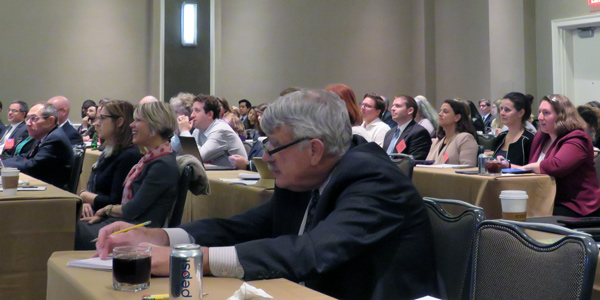By Rory D. Sweeney
WASHINGTON — Two panels at the Energy Bar Association’s Mid-Year Energy Forum on Tuesday offered starkly contrasting views of the future.
The opening morning panel focused on the future of carbon policy, with several panelists offering a potential future for coal. A later panel focused on the impact of increasing intermittent generation on the grid.
EPA Deputy General Counsel David Fotouhi said Administrator Scott Pruitt has targeted three coal-related environmental rules for reconsideration: the Clean Power Plan; 2015 steam-electric effluent limitations in the Clean Water Act; and the coal-combustion residuals rule in the Resource Conservation and Recovery Act.
“Those three efforts in common share the touchstones of rule of law, cooperative federalism and process, and making sure the process is regular,” Fotouhi said.
Disagreement over Coal ‘Bailout’

Paul Bailey, CEO of the American Coalition for Clean Coal Electricity, said he received no forewarning of the Department of Energy’s Sept. 29 Notice of Proposed Rulemaking calling for price supports for coal and nuclear facilities.
“We didn’t know this was going to happen until we saw it,” he said. “We’re also trying to understand this proposal like many others right now.”
He said his organization, which represents coal-fired generators, doesn’t view it as a bailout.
Marc Chupka of The Brattle Group said domestic coal production would be aided by the CPP repeal and improving mining techniques to reduce costs. However, he warned that inexpensive natural gas “will end up crushing coal.”
“There is very little that [coal-fired] generators can do in the face of $3 gas,” he said.
Benjamin Longstreth, an attorney with the Natural Resources Defense Council, disagreed with Bailey’s description of the DOE NOPR and said there was “an absolute lack of analysis to support the proposal.” He quoted Pruitt’s complaint that EPA was “picking winners and losers” in the CPP.
“I don’t agree with Pruitt’s description of the Clean Power Plan, but I think it aptly describes DOE’s proposal,” Longstreth said. “We view it as a bailout.”
The NOPR argues that retaining coal and nuclear facilities that have 90-day fuel supplies maintains grid reliability, but Longstreth said that only 0.007% of outages are due to fuel shortages.
Andrew McKeon, the executive director of the nine-state Regional Greenhouse Gas Initiative, said the past 200 years of economic prosperity has been “very closely tied” to fossil fuel use, but the two trends must “decouple” to address climate change.
“The fact is it’s a global problem and needs a global answer,” he said.
RGGI is providing one path, he said. The states involved — Delaware, Maryland, New York, Connecticut, Massachusetts, Rhode Island, Vermont, New Hampshire and Maine — have seen a 45% reduction in carbon dioxide emissions from electric generation since 2005.
“We’re doing the job twice as fast as the rest of the country,” he said.
Filling the Breach
All panelists acknowledged federalism and the importance of states making decisions on their own.
“We absolutely believe that states should step into the breach” left by Trump administration policies, Longstreth said.
New York is trying to be one of those states. In a later panel, NYISO’s Robert Pike explained New York’s analysis for implementing carbon pricing. The state is already providing renewable energy credits (RECs) and zero-emissions credits (ZECs) for nuclear facilities. The state commissioned a study by Brattle to determine if NYISO’s market could achieve the same function as its existing administrative solutions.
“It’s about a wash in costs,” Pike said. “The bills stay about the same for consumers because the carbon price would then offset the need for RECs and ZECs.”
Pike said there also are questions about how the DOE proposal would be applied. He noted a coal facility in New York that runs very infrequently.
“What does a 90-day coal pile look like at a unit that runs 1% of the time?” he asked.
Ralph Romero, of infrastructure developer Black & Veatch, said the cost of energy storage “has dropped dramatically” in recent years to between 40 and 50 cents/W depending on location. He said some analysts have predicted that $100/kWh for batteries by 2020 is “not beyond the realm of possibility.”
ICF International’s Kevin Petak joined with others in the natural gas pipeline industry who have said that securing firm pipeline capacity is complicated and not always feasible. He noted that while electricity can move at nearly the speed of light, gas moves about 30 mph, so suppliers require time and planning to ensure gas is physically available.
Pipeline companies have argued that gas-fired generators need to pay for uninterruptible pipeline deliveries if they want to ensure supplies, but Petak said generators aren’t able to recover that cost from customers.
Marketers can bundle capacity with the gas when they make contracts, he said, but “since there is no mechanism to buy the capacity and pass that cost on to the consumer, there has been reservation on the part of generators to reserve capacity.”










